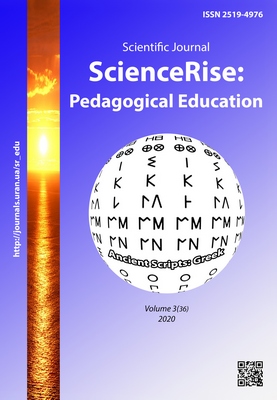The experimental testing of blended learning methods of oral Japanese lanuage teaching aimed at future philologists
DOI:
https://doi.org/10.15587/2519-4984.2020.201683Keywords:
blended learning models, implementation of the experiment, Japanese oral language evaluation criteriaAbstract
The study describes the characteristics of the experimental introduction of the methods of blended Japanese oral language teaching for future philologists, as well as the adequacy of the experimental method, aimed at testing the hypothesis of the study. It dwells upon the peculiarities of methodical experiment organization, which was aimed at finding out how effective can be four basic models of blended learning which were selected for teaching oral Japanese: “Face-to-Face Driver”, which was used to teach students of the first year of study, “Activities Rotation Model” for second-year students, “Working Space Rotation Model” which targeted third-year future philologists, and “Flipped Classroom Model” used among the students of the fourth year of the Bachelor's educational level. The experiment also included the use of three auxiliary models: “Flex Model”, aimed at working with the students, who study according to an individual schedule or are forced to catch up with certain material, “Online Lab Model”, aimed at organizing distance learning because of certain prerequisites and needs of the course, and “Self-Blend Model”, aimed at organizing independent study time for students, who are already independent users and are working on some additional courses. The experiment lasted for two years and was conducted at all the years (from first to fourth) of the Bachelor’s educational level. The article highlights the organizational and semantic aspects of experimental teaching using experimental verification capabilities in the research practice of developing oral Japanese skills among future philologists. The article also mentions the two variants of the author's methods, which differ according to the presence or absence of elements of microlearning (microsearch) during in-person training, and the second one was chosen as more preferrable. The results of the experiment proved that both of these variants turned out to be successful, although the presence of microsearch did not affect the level of competence in listening skill, monologue and dialogic speech
References
- Asadchykh, O. V., Filonova, V. O. (2018). Osnovy metodyky navchannia usnoho yaponskoho monolohichnoho movlennia na pochatkovomu rivni u vyshchii shkoli. Kyiv: Vydavnychyi dim Dmytra Buraho, 156.
- Holubets, V. V. (2003). Vykorystannia testovykh zavdan dlia navchannia studentiv movnykh spetsialnostei hramatychno pravylnoho yaponskoho movlennia. Kyiv, 252.
- Arakava, M. V. (2007). Formirovanie metodicheskoi kompetencii v obuchenii chteniyu na yaponskom yazyke u studentov starshih kursov pedagogicheskih vuzov: yaponskii yazyk kak vtoroi inostrannyi. Saint Petersburg, 24.
- Razdorskaya, N. V. (2007). Osobennosti obucheniya yaponskomu yazyku studentov-mezhdunarodnikov na osnove obshchestvenno-politicheskih tekstov. Moscow, 29.
- Avdeeva, E. S. (2009). Ispol'zovanie komiksov pri obuchenii yaponskomu yazyku studentov vtorogo kursa yazykovogo vuza. Moscow, 26.
- Ivanova, N. S. (2007). Kul'turovedcheskii podhod k obucheniyu studentov yazykovogo vuza yaponskomu yazyku kak vtoromu inostrannomu. Saint Petersburg, 26.
- Grunina, O. N. (2012). Metodika formirovaniya perevodcheskoi i informacionno-analiticheskoi kompetencii studentov v processe obucheniya yaponskomu yazyku s uchetom nacional'no-kul'turnoi specifiki nositelei yazyka. Moscow, 25.
- Gurvich, P. B. (1980). Teoriya i praktika eksperimenta v metodike prepodavaniya inostrannyh yazykov: speckurs. Vladimir: Izdatel'stvo Vladimirskogo pedagogicheskogo instituta im. P. I. Lebedeva-Polyanskogo, 104.
- Zabolotna, M. I. (2014). Metodyka navchannia audiiuvannia anhlomovnykh publitsystychnykh tekstiv starshoklasnykiv v umovakh profilnoho navchannia. Kyiv, 255.
- Fedorova, O. A. (2016). Formuvannia audytyvnykh umin inozemnykh slukhachiv pidhotovchoho viddilennia u protsesi navchannia ukrainskoi movy. Ivano-Frankivsk, 260.
- Druzhchenko, T. P. (2018). Metodyka dyferentsiiovanoho navchannia anhliiskoho usnoho monolohichnoho movlennia maibutnikh yurystiv. Kyiv, 268.
- Krysak, L. V. (2016). Metodyka navchannia maibutnikh likariv zahalnoi praktyky anhlomovnoho profesiino oriientovanoho dialohichnoho movlennia. Kyiv, 288.
Downloads
Published
How to Cite
Issue
Section
License
Copyright (c) 2020 Oksana Asadchih, Tetiana Dybska

This work is licensed under a Creative Commons Attribution 4.0 International License.
Our journal abides by the Creative Commons CC BY copyright rights and permissions for open access journals.
Authors, who are published in this journal, agree to the following conditions:
1. The authors reserve the right to authorship of the work and pass the first publication right of this work to the journal under the terms of a Creative Commons CC BY, which allows others to freely distribute the published research with the obligatory reference to the authors of the original work and the first publication of the work in this journal.
2. The authors have the right to conclude separate supplement agreements that relate to non-exclusive work distribution in the form in which it has been published by the journal (for example, to upload the work to the online storage of the journal or publish it as part of a monograph), provided that the reference to the first publication of the work in this journal is included.








